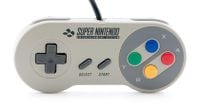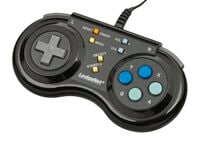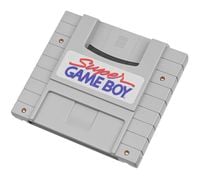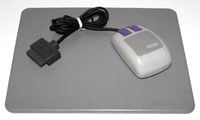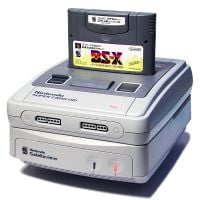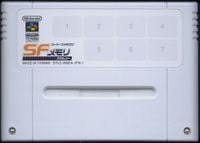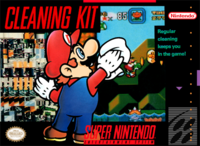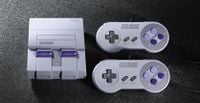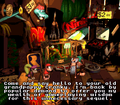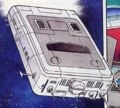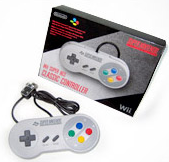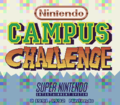Super Nintendo Entertainment System: Difference between revisions
No edit summary |
Bowserbros (talk | contribs) mNo edit summary |
||
| (356 intermediate revisions by more than 100 users not shown) | |||
| Line 1: | Line 1: | ||
{{ | {{system infobox | ||
| | |image=[[File:SNES Console.png|300px]] | ||
| | |generation=Fourth | ||
| | |release='''Super Nintendo Entertainment System/Super Famicom:'''<br>{{release|Japan|November 21, 1990|USA|August 23, 1991<ref>Nintendo of America (August 23, 2021). "[https://twitter.com/NintendoAmerica/status/1429820774907584512 On this day 30 years ago, the Super Nintendo Entertainment System launched in North America! What are some of your favorite #SNES games and memories?]". Twitter ([https://archive.is/OIYhz archive.is]). Retrieved March 11, 2022.</ref>|UK|April 11, 1992<ref>{{cite|author=|title="Super Nintendo Entertainment System (Platform)"|publisher=Giant Bomb|date=|archive=https://web.archive.org/web/20190330233608/https://www.giantbomb.com/super-nintendo-entertainment-system/3045-9/|accessdate=April 27, 2024}}</ref>|Ireland|April 11, 1992<ref>{{cite|author=|title="Super Nintendo Entertainment System (Platform)"|publisher=Giant Bomb|date=|archive=https://web.archive.org/web/20190330233608/https://www.giantbomb.com/super-nintendo-entertainment-system/3045-9/|accessdate=April 27, 2024}}</ref>|Europe|June 6, 1992<ref>{{cite|author=|title="Nintendo History"|publisher=Nintendo|date=|archive=https://archive.today/20120904134155/http://www.nintendo.co.uk/NOE/en_GB/service/nintendo_history_9911.html|accessdate=April 27, 2024}}</ref><ref>{{cite|author=|title="Super Nintendo Entertainment System (Platform)"|publisher=Giant Bomb|date=|archive=https://web.archive.org/web/20190330233608/https://www.giantbomb.com/super-nintendo-entertainment-system/3045-9/|accessdate=April 27, 2024}}</ref>|Chile|June 8, 1992<ref>[https://www.latercera.com/noticia/los-juegos-mas-recordados-a-25-anos-del-lanzamiento-de-la-super-nintendo/ "Los juegos más recordados a 25 años del lanzamiento de la Super Nintendo"]. La Tercera</ref>|Australia|July 3, 1992|Brazil|August 30, 1993<ref>https://www.tradeinpost.com/product/super-nintendo/</ref>}} '''Super NES Classic Edition:'''<br>{{release|USA|September 29, 2017|Europe|September 29, 2017|Australia|September 30, 2017|Japan|October 5, 2017}} | ||
| | |discontinued={{release|USA|1999<ref>Reisinger, Don. (Jan. 21, 2009). [https://www.cnet.com/news/does-the-xbox-360s-lack-of-longevity-matter/ Does the Xbox 360's 'lack of longevity' matter?] ''CNET''. Retrieved December 19, 2021.</ref>|Japan|September 25, 2003}} | ||
| | |ratings=Super NES Classic Edition:{{ratings|esrb=T|pegi=12|cero=B|acb=M|usk=12}} | ||
|predecessor=[[Nintendo Entertainment System]] | |||
|successor=[[Nintendo 64]] | |||
}} | }} | ||
{{ | {{quote2|Now you're playing with power. Super power!|Advertisement slogan for the SNES}} | ||
[[File:SNESLogo.svg|left|150px]] | |||
The '''{{wp|Super Nintendo Entertainment System}}''' (abbreviated as '''SNES''', '''Super NES''', or '''Super Nintendo'''), called the '''Super Famicom''' in Japan, is a video game console created by [[Nintendo]]. In early development, it was called '''Nintendo Entertainment System 2''' or '''NES2'''. The system first released in Japan on November 21, 1990, then in America on August 23, 1991, in Europe in April 1992, and in Australia in July 1992. The South Korean version was rebranded the Super Comboy and was distributed by {{wp|SK Hynix|Hyundai Electronics}} to circumvent the country's bans on Japanese cultural imports. It is the last Nintendo console that has a different design and name in North America and PAL regions. The PAL version is a mix between the Super Famicom and the American SNES, keeping the design of the Super Famicom, while using the name from the American version. The Super Nintendo Entertainment System is the successor to the original [[Nintendo Entertainment System]] and similarly went on to produce many popular games, many of which are ''[[Super Mario (franchise)|Super Mario]]'' games, most notably ''[[Super Mario World]]'', ''[[Donkey Kong Country]]'', and ''[[Super Mario World 2: Yoshi's Island]]''. | |||
Many early SNES cartridges had a long crevice spanning the cartridge. This was to prevent people from pulling the cartridges out when the system was turned on. These were produced as late as March 1993, as some early ''[[LylatWiki:Star Fox (game)|Star Fox]]'' cartridges were manufactured with this mold. Later SNES cartridges opted into a different design because people were possibly breaking their SNES units{{ref needed}}, at the very earliest of June 1993, as no ''[[Yoshi's Cookie]]'' or ''[[Mario is Missing!]]'' cartridges have this mold. | |||
The | The system's S-SMP audio chip, which used {{wp|Adaptive differential pulse-code modulation|ADPCM}} sample playback instead of a digital synthesizer like competing systems, was developed by consumer electronics company {{wp|Sony}}. The success of this partnership resulted in another deal to create the {{wp|Super NES CD-ROM}}, a planned peripheral for the SNES that would have been able to play CD-ROM discs, in response to the Japanese success of a similar add-on for the {{wp|TurboGrafx-16}}. However, because the contract would have given Sony full control of and royalties for CD-ROM titles, Nintendo publicly terminated their partnership and courted a new deal with {{wp|Philips}}, who previously co-developed the Compact Disc format with Sony throughout the 1970s. The Philips deal failed to result in a finished product, and instead, Philips was given the rights to use the ''[[Super Mario (franchise)|Super Mario]]'' and ''Zelda'' IPs for several titles on its own CD-based multimedia device, the [[Philips CD-i]]. Sony, meanwhile, would eventually release the {{wp|PlayStation (console)|PlayStation}} in response to its deal with Nintendo falling apart, considerably outselling the [[Nintendo 64]] during the late 1990s. Some ''[[Super Mario (franchise)|Super Mario]]'' games, such as ''[[Super Mario All-Stars]]'' and ''[[Super Mario World 2: Yoshi's Island]]'', were considered for the Super NES CD-ROM, only to be shifted to the base SNES following the add-on's cancellation.<ref>[https://tcrf.net/Development:Super_Mario_All-Stars#Alternative_Titles Development: Super Mario All-Stars]. ''The Cutting Room Floor''. Retrieved November 13, 2023.</ref><ref>''Nintendo Magazine System'' (AU) Issue #2, page 62. "''As mentioned in Nintendo News Network last issue, not much is known at this stage, but we believe that the Super CD will be the same size as the Super NES. It will connect by the external port on the Super NES and the two units will become one by piggybacking. Super Mario 5 is said to be coming out on Super CD.''"</ref> | ||
Because of the international rivalry between Nintendo and Sega, which competed against the SNES with their {{wp|Sega Genesis}}, many ''Super Mario'' games during this time included jabs at Sega's flagship series, ''[[sonicretro:Sonic the Hedgehog|Sonic the Hedgehog]]'', and vice versa. In ''[[Donkey Kong Country 2: Diddy's Kong Quest]]'', [[Sonic]]'s boots and the plasma gun from ''{{wp|Earthworm Jim}}'' are seen next to a bin and labeled "no hopers." In ''[[Super Mario World 2: Yoshi's Island]]'', there are [[Harry Hedgehog|blue hedgehog enemies]] that greatly resemble Sonic. | |||
The SNES was re-released as Super Famicom Jr. for Japan, and on October 20, 1997, it was released in North America as the {{wp|New-Style Super NES}}.<ref>[http://maru-chang.com/hard/shvc/english.htm#SNS-101 SNS-101]. Retrieved July 9, 2023.</ref> The newer model was smaller and lacked the eject button, and it also could not output the S-Video and RGB signals. | |||
{{ | |||
| | |||
}} | |||
The | |||
==Accessories== | ==Accessories== | ||
===SNES Controller=== | ===SNES Controller=== | ||
[[File:SNES Controller.jpg | [[File:SNES Controller.jpg|thumb|Original Japanese and PAL controller]] | ||
The SNES Controller is the main controller for the SNES which had a layout which popularized the layout used by most modern controllers. It was also the first controller to have shoulder buttons. | The SNES Controller is the main controller for the SNES which had a layout which popularized the layout used by most modern controllers. It was also the first controller to have shoulder buttons. The controller is more round-shaped instead of rectangle-shaped from the [[Nintendo Entertainment System|NES]] controller. It has the {{button|snes|A}}, {{button|snes|B}}, {{button|snes|start}}, and {{button|snes|select}} buttons and the {{button|snes|Pad}} from the NES, plus four extra buttons: the {{button|snes|X}}, {{button|snes|Y}}, {{button|snes|L}}, and {{button|snes|R}} buttons. | ||
The American controller is slightly different from the Japanese and the | The American controller is slightly different from the Japanese and the PAL controllers. Instead of having each button be a different bright color, the {{button|snes|A}} and {{button|snes|B}} buttons were purple and the {{button|snes|X}} and {{button|snes|Y}} buttons were lavender, tying into the mechanical color scheme of the SNES's American model. | ||
There is also a Wii adaption of the SNES controller for use as a substitution for the Classic Controller with games that support said controller. | |||
There | [[File:LodgeNet-Super-Nintendo-Controller.jpg|thumb|LodgeNet SNES Controller]] | ||
There was also a [[LodgeNet]] version for hotels.<ref>Nintendrew (August 15, 2018). [https://www.youtube.com/watch?v=HK_EPiRkFew&ab_channel=Nintendrew LodgeNet Game Controllers - Nintendo's Hotel Rental Service! | Nintendrew] ''YouTube''. Retrieved March 4, 2020.</ref> | |||
{{br}} | |||
=== | ===Super Game Boy=== | ||
[[File: | {{main|Super Game Boy}} | ||
The | [[File:NASuperGameBoy.jpg|thumb|Super Game Boy cartridge]] | ||
The Super Game Boy is a cartridge adapter that allows play of all [[Game Boy]] games, as well as [[Game Boy Color]] games that were made backwards compatible to work on the original Game Boy, on the Super Nintendo. Some Game Boy games are labeled as enhanced for Super Game Boy, such as ''[[Donkey Kong (Game Boy)|Donkey Kong]]''. | |||
{{br}} | |||
The | ===Super NES Mouse=== | ||
[[File:SNESMouse.JPG|thumb|The Super NES Mouse]] | |||
The Super NES Mouse was an accessory for certain Super NES games. It was compatible only with the SNES and was thus only used in the early-to-mid-1990s. The Super NES Mouse mimics the appearance and action of an actual computer mouse; the Super NES Mouse controlled the cursor in some ''Super Mario'' games. | |||
====''Mario'' | The Super NES Mouse was originally bundled with ''Mario Paint'' and a mouse pad for $59.95. | ||
====''Super Mario'' games compatible with the Super NES Mouse==== | |||
*''[[Mario Paint]]'' | *''[[Mario Paint]]'' | ||
*''[[Mario & Wario]]'' | *''[[Mario & Wario]]'' | ||
| Line 62: | Line 51: | ||
*''[[Mario's Early Years! Fun with Numbers]]'' | *''[[Mario's Early Years! Fun with Numbers]]'' | ||
*''[[Mario's Early Years! Preschool Fun]]'' | *''[[Mario's Early Years! Preschool Fun]]'' | ||
*''[[Undake30 Same Game|Undake 30 Same Game Daisakusen Mario Version]]'' | |||
===Super Scope=== | ===Super Scope=== | ||
{{main|Super Scope}} | {{main|Super Scope}} | ||
The SNES Super Scope is a | [[File:Gal nintendo 13 super-scope.jpg|thumb|The Super Scope]] | ||
The SNES Super Scope is a {{wp|light gun}} accessory for the SNES. It has one "fire" button for shooting, either in single bursts or a constant stream, depending on whether or not its on/off switch is set to "turbo". It also has a second "cursor" button and a "pause" button. It was used for very few games, including one ''Super Mario'' title, ''[[Yoshi's Safari]]''. | |||
{{br}} | {{br}} | ||
===Super Multitap=== | |||
[[File:SNES Super Multitap.jpg|thumb|Super Multitap]] | |||
The '''Super Multitap''', by [[Hudson Soft]], allowed to turn the player 2 controller port into four controller ports, allowing for up to five simultaneous players, but only if the game supports it. Although no ''Super Mario'' game for the SNES uses the Super Multitap, the [[Game Boy]] game ''[[Wario Blast: Featuring Bomberman!]]'' can use the accessory if played in a [[Super Game Boy]], although the game never uses the fifth available controller slot. | |||
== | ===Satellaview=== | ||
[[File: | {{main|Satellaview}} | ||
A | [[File:Satellaview.jpg|thumb|Satellaview under a Super Famicom with special cartridge]] | ||
A Japan-exclusive add-on for the Super Famicom was the Satellaview. It was the earliest known, commercially available, licensed product by Nintendo to connect to the internet and download games. The Super Famicom Jr. is incompatible with Satellaview because of the missing port underneath the first model had. | |||
{{br}} | {{br}} | ||
== | ===SF Memory Cassette=== | ||
{{main|Nintendo Power (cartridge)}} | |||
[[File:Nintendo Power SF Memory Cassette.jpg|thumb]] | |||
Only in Japan, the SF Memory Cassette is a rewritable version of regular cartridges, through kiosks at retail stores between 1997-2007. | |||
{{br}} | |||
=== Cleaning Kit === | |||
[[File:SNES Cleaning Kit Alt.png|thumb|Mario-themed cleanup kit]] | |||
Over time, pins inside the SNES and game cartridges would get dirty. Nintendo released an approved cleaning kit to improve the condition of the contacts so games would play without interruption. | |||
{{br}} | |||
==Super NES Classic Edition== | |||
[[File:SuperNES-ClassicEdition.jpg|thumb|200px|Super NES Classic Edition]] | |||
{{main|Classics#Super NES Classic Edition}} | |||
Announced on June 26, 2017, the '''Super NES Classic Edition''' (known as the '''Nintendo Classic Mini: Super Nintendo Entertainment System''' in Europe and Australia and '''Nintendo Classic Mini: Super Famicom''' in Japan) is a smaller version of the Super Nintendo Entertainment System, and the successor to the [[Classics#NES Classic Edition|NES Classic Edition]]. It comes with 21 pre-installed SNES games, including five games in the [[Super Mario (franchise)|''Super Mario'' franchise]]: ''[[Super Mario World]]'', ''[[Super Mario Kart]]'', ''[[Donkey Kong Country]]'', ''[[Super Mario World 2: Yoshi's Island]]'', and ''[[Super Mario RPG: Legend of the Seven Stars]]''. It was released on September 29, 2017 in North America and Europe, September 30 in Oceania, and October 5 in Japan. | |||
==Appearances in the ''Super Mario'' franchise== | |||
''[[Super Mario World]]'' had a [[Special Zone]] that used the logo for the Japanese and European markets. | |||
In ''[[Donkey Kong Country 2: Diddy's Kong Quest]]'', giant SNES controllers appear in both [[Monkey Museum]] and the Interior of [[The Flying Krock]]. | |||
A spaceship shaped like the PAL version of the SNES appeared in the 1997 ''[[Club Nintendo (magazine)|Club Nintendo]]'' comic, "[[Die Jagd nach dem Nintendo 64: Krawall im All]]". It was used as a metaphor, referring to the discontinuation of the console, and the launch of the [[Nintendo 64]]. In the comic, [[Mario]] and [[Luigi]] traveled with this spaceship, in search for a new one. During their quest they had to compete against [[Wario]] and [[Bowser]] who chased after the new spaceship as well. At the end of the comic, the spacecraft turned out to be the Nintendo 64 and the plumbers went on to take possession of it (abandoning the SNES-spaceship), being hailed by several of their friends. | |||
The SNES is also used as the setting for the [[microgame]] [[Super Nostalgic Entertainment System]] in ''[[WarioWare: Smooth Moves]]''. | |||
In ''[[Super Mario Odyssey]]'', one of the filters that is available for use in [[Snapshot Mode]] is the graphics style of the SNES. | |||
<gallery> | |||
SpecialZone SMW.png|''Super Mario World'' | |||
Monkey Museum DKC2.png|''Donkey Kong Country 2: Diddy's Kong Quest'' | |||
The Flying Krock DKC2 NTSC.png|''Donkey Kong Country 2: Diddy's Kong Quest'' | |||
WWSM Super Nostalgic Entertainment System.png|''WarioWare: Smooth Moves'' | |||
SSBM HALTV.png|''Super Smash Bros. Melee'' | |||
SPM Francisroomright.png|''Super Paper Mario'' | |||
SNESCN.jpg|Mario and Luigi's SNES-like spaceship. | |||
</gallery> | |||
==References in later console generations== | |||
[[File:WiiclassicSNES.png|thumb]] | |||
For the Australian [[Club Nintendo (rewards program)|Club Nintendo]], it had a reward option to request a [[Wii#Classic Controller|Wii Classic Controller]] themed after a European SNES controller. | |||
{{br}} | |||
==''Super Mario'' game gallery== | |||
''<gallery> | ''<gallery> | ||
Boxart dkc front.png|[[Donkey Kong Country]] | |||
DKC Competition Cartridge Boxart.jpg|[[Donkey Kong Country Competition Cartridge]] | |||
DKC2.jpg|[[Donkey Kong Country 2: Diddy's Kong Quest]] | |||
DKC3 cover art.jpg|[[Donkey Kong Country 3: Dixie Kong's Double Trouble!]] | |||
MnW cover art.jpg|[[Mario & Wario]] | |||
mism1.jpg|[[Mario is Missing!]] | |||
MarioPaintBox.jpg|[[Mario Paint]] | |||
Mariopre3.jpg|[[Mario's Early Years! Fun with Letters]] | |||
Mariopre2.jpg|[[Mario's Early Years! Fun with Numbers]] | |||
Mariopre1.jpg|[[Mario's Early Years! Preschool Fun]] | |||
Mariopicross2.jpg|[[Mario's Super Picross]] | |||
Mario's Time Machine Box Art.jpg|[[Mario's Time Machine]] | |||
NCCTitleScreen.png|[[Nintendo Campus Challenge]] | |||
NP94Logo.jpg|[[Nintendo PowerFest '94]] | |||
Pnp-logo.png|[[Picross NP]] | |||
SMAS.jpg|[[Super Mario All-Stars]] | |||
SMAS_SMW.jpg|[[Super Mario All-Stars + Super Mario World]] | |||
Super Mario Kart NA box art.png|[[Super Mario Kart]] | |||
Super Mario RPG Box.png|[[Super Mario RPG: Legend of the Seven Stars]] | |||
Super Mario World Box.png|[[Super Mario World]] | |||
SMW2.jpg|[[Super Mario World 2: Yoshi's Island]] | |||
TetrisDrMario.jpg|[[Tetris & Dr. Mario]] | |||
TAT.jpg|[[Tetris Attack]] | |||
Samegamecart.jpg|[[Undake30 Same Game]] | |||
WariosWoodsCover(USA).png|[[Wario's Woods]] | |||
WC98 Boxart.jpg|[[Wrecking Crew '98]] | |||
Yoshi'sCookieSNES.jpg|[[Yoshi's Cookie]] | |||
Snesyoshissafari.png|[[Yoshi's Safari]] | |||
Yoshi no Cookie JP Box.png|[[Yoshi no Cookie: Kuruppon Oven de Cookie]] | |||
</gallery>'' | |||
===''Super Mario World'' cartridges=== | |||
<gallery> | |||
SMW Cartridge 1.jpg|NTSC-U first version | |||
SMW Cartridge 2.jpg|NTSC-U second version | |||
SMW Cartridge 3.jpg|NTSC-U third version | |||
SMW Cartridge 4.jpg|NTSC-J version | |||
SMW Cartridge 5.jpg|PAL SNES first version | |||
SMW Cartridge 6.jpg|PAL SNES second version | |||
SMW Cartridge 7.jpg|NTSC-U [[Player's Choice]] version | |||
</gallery> | |||
==System gallery== | |||
<gallery> | |||
SNES Japan PAL Logo.svg|Japan and PAL logo, sport bright colors, resembling the shape of the four main buttons on the controller | |||
SNES North American Logo.png|North American logo, which has a more muted tone than the Japanese logo, having a simpler gray and black color scheme. | |||
Snes jap.jpg|Super Famicom | |||
SNES.jpg|The SNES in Europe and Australia | |||
SuperFamicom jr.jpg|Super Famicom Jr. | |||
SNES2.jpg|New-Style Super NES | |||
SNES Box SMW.jpg|Super NES Super Set (includes ''Super Mario World'') | |||
SNES Box SMAS.jpg|Super NES Mario Set (includes ''Super Mario All-Stars + Super Mario World'') | |||
SNES Box DKC.jpg|Super NES Donkey Kong Set (includes ''Donkey Kong Country'') | |||
SNES 2 Box.jpg|Standard SNES 2 package | |||
Super nintendo sns-101 box.jpg|SNES 2 package (includes ''Super Mario World 2: Yoshi's Island'') | |||
Super NES Player's Guide.jpg|Super NES [[Nintendo Power#Nintendo Player's Guide Gallery|Nintendo Player's Guide]] | |||
Twitter NintendoAUNZ 2017-10-22c.jpg|Image macro from the official NintendoAUNZ social media accounts, showing ''Super Mario'' games for the SNES | |||
</gallery> | </gallery> | ||
== | ==External links== | ||
* | {{NIWA|Bulbapedia=1|FZeroWiki=1|FireEmblem=Super Famicom|LylatWiki=1|MetroidWiki=1|NWiki=1|SmashWiki=Chronicle#Super Nintendo Entertainment System|StrategyWiki=Category:SNES|WarsWiki=1|WiKirby=1|WikiBound=1|ZeldaWiki=1}} | ||
*{{wp|Sonifi Solutions}} (Wikipedia) – A company that has brought Nintendo systems, including the SNES, to hotel rooms | |||
==References== | ==References== | ||
<references/> | <references/> | ||
{{SNES}} | {{SNES}} | ||
{{Systems}} | |||
[[Category:Systems]] | |||
[[de:Super Nintendo Entertainment System]] | |||
[[it:Super Nintendo Entertainment System]] | |||
Revision as of 04:02, April 28, 2024
| Super Nintendo Entertainment System | |||||||||||
|---|---|---|---|---|---|---|---|---|---|---|---|
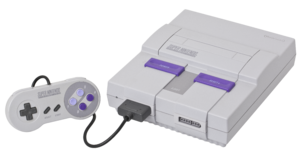
| |||||||||||
| Generation | Fourth generation | ||||||||||
| Release date | Super Nintendo Entertainment System/Super Famicom: Super NES Classic Edition: | ||||||||||
| Discontinued | |||||||||||
| Ratings | Super NES Classic Edition:
| ||||||||||
| Predecessor | Nintendo Entertainment System | ||||||||||
| Successor | Nintendo 64 | ||||||||||
- “Now you're playing with power. Super power!”
- —Advertisement slogan for the SNES
The Super Nintendo Entertainment System (abbreviated as SNES, Super NES, or Super Nintendo), called the Super Famicom in Japan, is a video game console created by Nintendo. In early development, it was called Nintendo Entertainment System 2 or NES2. The system first released in Japan on November 21, 1990, then in America on August 23, 1991, in Europe in April 1992, and in Australia in July 1992. The South Korean version was rebranded the Super Comboy and was distributed by Hyundai Electronics to circumvent the country's bans on Japanese cultural imports. It is the last Nintendo console that has a different design and name in North America and PAL regions. The PAL version is a mix between the Super Famicom and the American SNES, keeping the design of the Super Famicom, while using the name from the American version. The Super Nintendo Entertainment System is the successor to the original Nintendo Entertainment System and similarly went on to produce many popular games, many of which are Super Mario games, most notably Super Mario World, Donkey Kong Country, and Super Mario World 2: Yoshi's Island.
Many early SNES cartridges had a long crevice spanning the cartridge. This was to prevent people from pulling the cartridges out when the system was turned on. These were produced as late as March 1993, as some early Star Fox cartridges were manufactured with this mold. Later SNES cartridges opted into a different design because people were possibly breaking their SNES units[citation needed], at the very earliest of June 1993, as no Yoshi's Cookie or Mario is Missing! cartridges have this mold.
The system's S-SMP audio chip, which used ADPCM sample playback instead of a digital synthesizer like competing systems, was developed by consumer electronics company Sony. The success of this partnership resulted in another deal to create the Super NES CD-ROM, a planned peripheral for the SNES that would have been able to play CD-ROM discs, in response to the Japanese success of a similar add-on for the TurboGrafx-16. However, because the contract would have given Sony full control of and royalties for CD-ROM titles, Nintendo publicly terminated their partnership and courted a new deal with Philips, who previously co-developed the Compact Disc format with Sony throughout the 1970s. The Philips deal failed to result in a finished product, and instead, Philips was given the rights to use the Super Mario and Zelda IPs for several titles on its own CD-based multimedia device, the Philips CD-i. Sony, meanwhile, would eventually release the PlayStation in response to its deal with Nintendo falling apart, considerably outselling the Nintendo 64 during the late 1990s. Some Super Mario games, such as Super Mario All-Stars and Super Mario World 2: Yoshi's Island, were considered for the Super NES CD-ROM, only to be shifted to the base SNES following the add-on's cancellation.[9][10]
Because of the international rivalry between Nintendo and Sega, which competed against the SNES with their Sega Genesis, many Super Mario games during this time included jabs at Sega's flagship series, Sonic the Hedgehog, and vice versa. In Donkey Kong Country 2: Diddy's Kong Quest, Sonic's boots and the plasma gun from Earthworm Jim are seen next to a bin and labeled "no hopers." In Super Mario World 2: Yoshi's Island, there are blue hedgehog enemies that greatly resemble Sonic.
The SNES was re-released as Super Famicom Jr. for Japan, and on October 20, 1997, it was released in North America as the New-Style Super NES.[11] The newer model was smaller and lacked the eject button, and it also could not output the S-Video and RGB signals.
Accessories
SNES Controller
The SNES Controller is the main controller for the SNES which had a layout which popularized the layout used by most modern controllers. It was also the first controller to have shoulder buttons. The controller is more round-shaped instead of rectangle-shaped from the NES controller. It has the ,
,
, and
buttons and the
![]() from the NES, plus four extra buttons: the
from the NES, plus four extra buttons: the ,
,
, and
buttons.
The American controller is slightly different from the Japanese and the PAL controllers. Instead of having each button be a different bright color, the and
buttons were purple and the
and
buttons were lavender, tying into the mechanical color scheme of the SNES's American model.
There is also a Wii adaption of the SNES controller for use as a substitution for the Classic Controller with games that support said controller.
There was also a LodgeNet version for hotels.[12]
Super Game Boy
- Main article: Super Game Boy
The Super Game Boy is a cartridge adapter that allows play of all Game Boy games, as well as Game Boy Color games that were made backwards compatible to work on the original Game Boy, on the Super Nintendo. Some Game Boy games are labeled as enhanced for Super Game Boy, such as Donkey Kong.
Super NES Mouse
The Super NES Mouse was an accessory for certain Super NES games. It was compatible only with the SNES and was thus only used in the early-to-mid-1990s. The Super NES Mouse mimics the appearance and action of an actual computer mouse; the Super NES Mouse controlled the cursor in some Super Mario games.
The Super NES Mouse was originally bundled with Mario Paint and a mouse pad for $59.95.
Super Mario games compatible with the Super NES Mouse
- Mario Paint
- Mario & Wario
- Mario's Early Years! Fun with Letters
- Mario's Early Years! Fun with Numbers
- Mario's Early Years! Preschool Fun
- Undake 30 Same Game Daisakusen Mario Version
Super Scope
- Main article: Super Scope
The SNES Super Scope is a light gun accessory for the SNES. It has one "fire" button for shooting, either in single bursts or a constant stream, depending on whether or not its on/off switch is set to "turbo". It also has a second "cursor" button and a "pause" button. It was used for very few games, including one Super Mario title, Yoshi's Safari.
Super Multitap
The Super Multitap, by Hudson Soft, allowed to turn the player 2 controller port into four controller ports, allowing for up to five simultaneous players, but only if the game supports it. Although no Super Mario game for the SNES uses the Super Multitap, the Game Boy game Wario Blast: Featuring Bomberman! can use the accessory if played in a Super Game Boy, although the game never uses the fifth available controller slot.
Satellaview
- Main article: Satellaview
A Japan-exclusive add-on for the Super Famicom was the Satellaview. It was the earliest known, commercially available, licensed product by Nintendo to connect to the internet and download games. The Super Famicom Jr. is incompatible with Satellaview because of the missing port underneath the first model had.
SF Memory Cassette
- Main article: Nintendo Power (cartridge)
Only in Japan, the SF Memory Cassette is a rewritable version of regular cartridges, through kiosks at retail stores between 1997-2007.
Cleaning Kit
Over time, pins inside the SNES and game cartridges would get dirty. Nintendo released an approved cleaning kit to improve the condition of the contacts so games would play without interruption.
Super NES Classic Edition
- Main article: Classics#Super NES Classic Edition
Announced on June 26, 2017, the Super NES Classic Edition (known as the Nintendo Classic Mini: Super Nintendo Entertainment System in Europe and Australia and Nintendo Classic Mini: Super Famicom in Japan) is a smaller version of the Super Nintendo Entertainment System, and the successor to the NES Classic Edition. It comes with 21 pre-installed SNES games, including five games in the Super Mario franchise: Super Mario World, Super Mario Kart, Donkey Kong Country, Super Mario World 2: Yoshi's Island, and Super Mario RPG: Legend of the Seven Stars. It was released on September 29, 2017 in North America and Europe, September 30 in Oceania, and October 5 in Japan.
Appearances in the Super Mario franchise
Super Mario World had a Special Zone that used the logo for the Japanese and European markets.
In Donkey Kong Country 2: Diddy's Kong Quest, giant SNES controllers appear in both Monkey Museum and the Interior of The Flying Krock.
A spaceship shaped like the PAL version of the SNES appeared in the 1997 Club Nintendo comic, "Die Jagd nach dem Nintendo 64: Krawall im All". It was used as a metaphor, referring to the discontinuation of the console, and the launch of the Nintendo 64. In the comic, Mario and Luigi traveled with this spaceship, in search for a new one. During their quest they had to compete against Wario and Bowser who chased after the new spaceship as well. At the end of the comic, the spacecraft turned out to be the Nintendo 64 and the plumbers went on to take possession of it (abandoning the SNES-spaceship), being hailed by several of their friends.
The SNES is also used as the setting for the microgame Super Nostalgic Entertainment System in WarioWare: Smooth Moves.
In Super Mario Odyssey, one of the filters that is available for use in Snapshot Mode is the graphics style of the SNES.
References in later console generations
For the Australian Club Nintendo, it had a reward option to request a Wii Classic Controller themed after a European SNES controller.
Super Mario game gallery
Super Mario World cartridges
NTSC-U Player's Choice version
System gallery
Super NES Nintendo Player's Guide
External links
- Sonifi Solutions (Wikipedia) – A company that has brought Nintendo systems, including the SNES, to hotel rooms
References
- ^ Nintendo of America (August 23, 2021). "On this day 30 years ago, the Super Nintendo Entertainment System launched in North America! What are some of your favorite #SNES games and memories?". Twitter (archive.is). Retrieved March 11, 2022.
- ^ "Super Nintendo Entertainment System (Platform)". Giant Bomb. Retrieved April 27, 2024. (Archived March 30, 2019, 23:36:08 UTC via Wayback Machine.)
- ^ "Super Nintendo Entertainment System (Platform)". Giant Bomb. Retrieved April 27, 2024. (Archived March 30, 2019, 23:36:08 UTC via Wayback Machine.)
- ^ "Nintendo History". Nintendo. Retrieved April 27, 2024. (Archived September 4, 2012, 13:41:55 UTC via archive.today.)
- ^ "Super Nintendo Entertainment System (Platform)". Giant Bomb. Retrieved April 27, 2024. (Archived March 30, 2019, 23:36:08 UTC via Wayback Machine.)
- ^ "Los juegos más recordados a 25 años del lanzamiento de la Super Nintendo". La Tercera
- ^ https://www.tradeinpost.com/product/super-nintendo/
- ^ Reisinger, Don. (Jan. 21, 2009). Does the Xbox 360's 'lack of longevity' matter? CNET. Retrieved December 19, 2021.
- ^ Development: Super Mario All-Stars. The Cutting Room Floor. Retrieved November 13, 2023.
- ^ Nintendo Magazine System (AU) Issue #2, page 62. "As mentioned in Nintendo News Network last issue, not much is known at this stage, but we believe that the Super CD will be the same size as the Super NES. It will connect by the external port on the Super NES and the two units will become one by piggybacking. Super Mario 5 is said to be coming out on Super CD."
- ^ SNS-101. Retrieved July 9, 2023.
- ^ Nintendrew (August 15, 2018). LodgeNet Game Controllers - Nintendo's Hotel Rental Service! | Nintendrew YouTube. Retrieved March 4, 2020.
| Video game systems and add-ons | |
|---|---|
| Nintendo home consoles | Nintendo Entertainment System/Family Computer (Family BASIC, Family Computer Disk System) • Super Nintendo Entertainment System/Super Famicom (Satellaview, Super Game Boy) • Nintendo 64 (Nintendo 64DD) • Nintendo GameCube (Game Boy Player) • Wii (Virtual Console, WiiWare) • Wii U (Virtual Console) |
| Nintendo handhelds | Game & Watch • Game Boy • Virtual Boy • Game Boy Color • Game Boy Advance • Nintendo DS (Nintendo DSi, DSiWare) • Nintendo 3DS (Virtual Console) |
| Other | MS-DOS • VS. System • Nintendo PlayChoice-10 • Nelsonic Game Watch • Super Mario Bros. Watch • Gamewatch Boy • Philips CD-i • Mini Classics • Nintendo Switch • Triforce • Visteon Dockable Entertainment System • Classics • LodgeNet |
